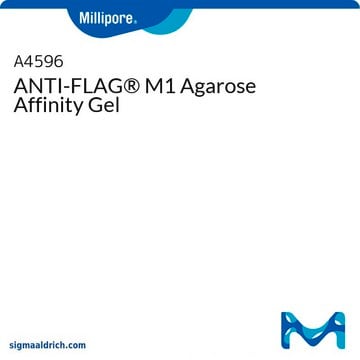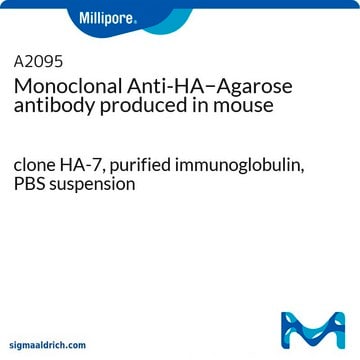11815024001
Roche
Anti-Protein C Affinity Matrix
from mouse IgG1κ
Sinónimos:
affinity matrix, anti-protein c
About This Item
Productos recomendados
biological source
mouse
Quality Level
conjugate
agarose conjugate
antibody form
purified immunoglobulin
clone
HPC4, monoclonal
form
slurry
packaging
pkg of 1 mL (settled resin volume)
manufacturer/tradename
Roche
isotype
IgG1, kappa
capacity
2-10 nmol/mL binding capacity
storage temp.
2-8°C
General description
- Insertion of the protein C tag does not introduce a new metal-ion binding site. The antibody contains the Ca2+ binding site.
- Protein C tag can be integrated either at the N-terminus, C-terminus or internally without any change in antibody specificity.
- Rapid immunoaffinity purification under non-denaturing conditions using economical calcium chelating agent (e.g., EDTA) or alternatively a specific protein C-tag peptide.
Monoclonal mouse antibody Anti-Protein C (clone HPC4) is covalently coupled to agarose beads. In the coupling reaction 4mg of antibody is reacted per 1ml of beads.
Specificity
Application
- Immunoprecipitation of Protein C-tagged proteins from mammalian, bacterial, and yeast cell extracts
- Affinity column purification of Protein C-tagged proteins from crude protein extracts
Following immunoprecipitation or purification, the tagged protein of interest may be analyzed by:
- Western blotting using the Anti-Protein C antibody
- Silver staining (or similar protein stain)
Features and Benefits
- use gentle elution conditions using calcium-chelating agents like EDTA.
- highly specific to EDQVDPRLIDGK, derived from protein C.
- binding of Anti-Protein C to protein C-epitop is dependent on the presence of calcium ions.
- suitable for purification of proteins containing protein C as N-terminal, C-terminal or internal fusion.
- applicable with crued cell extracts from mammalian, bacterial, and yeast expression systems.
Contents
1. The antibody is covalently coupled to agarose beads and supplied as a 2ml slurry containing 1ml beads and 1ml buffer.
2. 4mg of antibody is reacted per ml of beads in the coupling reaction.
3. A plastic column with top and bottom caps is included.
Packaging
Quality
Physical form
Analysis Note
Other Notes
Storage Class
12 - Non Combustible Liquids
wgk_germany
WGK 1
flash_point_f
does not flash
flash_point_c
does not flash
Certificados de análisis (COA)
Busque Certificados de análisis (COA) introduciendo el número de lote del producto. Los números de lote se encuentran en la etiqueta del producto después de las palabras «Lot» o «Batch»
¿Ya tiene este producto?
Encuentre la documentación para los productos que ha comprado recientemente en la Biblioteca de documentos.
Nuestro equipo de científicos tiene experiencia en todas las áreas de investigación: Ciencias de la vida, Ciencia de los materiales, Síntesis química, Cromatografía, Analítica y muchas otras.
Póngase en contacto con el Servicio técnico








